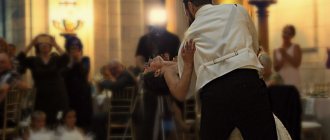Hello my dear readers!
If you want to learn to dance the waltz, but there is no desire or opportunity to attend a ballroom dancing section, then try to do it yourself or with a coach. Learning to waltz is challenging, challenging and very fun and can be a great way to spend time with your partner.
The peculiarity and beauty of the waltz lies in the smooth and continuous whirling of dancing couples, harmoniously combined with the general line of the dance, which involves the movement of all couples in a circle. The liveliness, simplicity and spontaneity of the dance gives a special atmosphere to the ceremonial aristocratic salons, where complex gavottes and minuets reigned.
By the way, waltz for beginners is a fairly interesting and simple activity that is quickly mastered and gives the dancer great pleasure. Of course, waltz training should take place at a dance school, since it is quite difficult to master the steps and actions from books. This is more suitable for those who already have an understanding of the basic movements or have simply missed a few aspects of the dance and want to catch up.
How to learn to dance slow waltzes? Lessons at a dance school are the ideal solution to this problem. The workout includes a warm-up, during which the body's muscles warm up. Thus, nothing will hinder the dancer’s body and movements.
Only after this should the movements, steps and steps be practiced. Waltz lessons involve dancing in pairs. But don’t worry if you don’t have a partner - people come to many dance schools without a partner, so there will always be company. An interesting choice would be the Viennese, French or figure waltzes, the Waltz of Friendship and the Boston.
Forever young waltz for newlyweds and guests
They say that in the good old days, when time flowed slowly and people had enough time to communicate, wedding celebrations were modest but sincere. And it doesn’t matter that instead of a fancy stereo system (or a DJ with a set of sound-reproducing equipment), a self-taught accordionist or an amateur orchestra created the mood for the guests. The newlyweds, their families, friends and loved ones had enough music to enjoy dancing at the celebration. Because almost everyone knew how to dance.
Today, a person who can dance well is becoming a rarity. The proposed dance scheme will allow future spouses not only to feel confident on the floor, but also to act as dance stewards, organizing for friends and guests first a kind of express course in waltz, and then a synchronized and spectacular performance of the learned material (today it is called a flash mob ). The movements of the dance number (unofficial name “50 grams”) are so simple that they can be mastered in literally half an hour (especially after 50 grams of good cognac “for courage”).
How to effectively learn to dance the waltz at home?
Before you start learning, you need to set your priorities. What is important to you – learn to dance professionally or twirl in a beautiful outfit at a theme evening. If your skill is more important to you, then you should find a private teacher.
- First of all, personal training will allow you to effectively plan your free time. A personal teacher will give an objective assessment of your prospects and help you achieve your goal. In order to go as deep as possible into the dance process, take the time to familiarize yourself with information about the types of waltz, their history and features.
- In order to learn any type of dance, you need to learn to feel the rhythm of the music. One option is to do household chores while listening to waltz tunes. Listen to the musical transitions. Try dancing in your mind to the music playing.
- Whenever possible, hone your skills with training videos. The privacy of your home will help you concentrate on the process. The video allows you to return to problematic moments and repeat the desired movements. This way, you will be able to tighten up the complex elements of the lesson, having your own time and without making additional financial investments. If you can’t find suitable lessons, you can purchase already prepared training material on disk.
Waltz
- If among your friends there are experienced dancers, then do not miss the opportunity to work out with such a person. This will allow you to correct your mistakes and receive valuable comments. It is best to combine a set of activities. Work out at home, with a trainer, attend open classes and special events. Try dancing with new partners.
Love what you do. Surround yourself with romance and beautiful dance attributes. Make learning to dance your hobby. Then you are guaranteed to achieve a successful result.
About the waltz very briefly (“galloping across Europe”)
Several European countries - France, the Czech Republic, Germany and Austria - contributed talent, hands and feet to the birth and development of the dance.
The debate about where exactly the eternally young waltz was born continues to this day. Those interested can read about it here: https://tango-beregovo.blogspot.com/2015/05/blog-post_73.html The fast waltz (better known by the romantic name Viennese) is a relatively simple dance. However, its speed often becomes an almost insurmountable obstacle for beginning dancers.
The British, as usual, changed the European waltz almost beyond recognition. Its main difference from the Viennese one is the almost twice as slow rhythm and the abundance of complex, spectacular figures. More information about the slow waltz can be found here https://tango-beregovo.blogspot.com/2015/05/blog-post.html.
You are offered a simple pattern, which is performed to a moderate rhythm (not as fast as the Viennese waltz, but not as slow as the English one). In addition, the main step of the dance sequence has been specially simplified so that untrained people can quickly master it.
Not sure you can handle the waltz? You can try another dance. For example tango, salsa or cha-cha-cha.
Good luck to beginners!
Life, views on music and fashion change, but the waltz has always been and will remain forever one of the favorite dances around the world. To comprehend the mystery of performing a waltz, you need to work hard on yourself, feel the melody, and not be shy about your partner.
Let your heart beat to the rhythm of a waltz, and let your soul fly into the air like a songbird. According to doctors, waltz has a beneficial effect on the functioning of the cardiovascular system, so we strengthen not only our dancing skills, but also our health!
Confident Leading
In pair dances, the roles have long been distributed - the partner leads, the lady follows. Accordingly, the partner takes the lady by the hand, and not vice versa (which is often the “sin” of overly emancipated persons).
While performing dance numbers and changing positions, the partner intercepts the lady’s hand in different ways to make it more convenient to guide her. Partners need to try not to grab onto each other like a life preserver. So it won't be long before injuries!
Confidence on the floor is gained through numerous training sessions.
At the end of the preparation, it is advisable to conduct several dress rehearsals in wedding suits and shoes (it is advisable to immediately eliminate all noticed shortcomings), and certainly in the presence of several spectators. After a series of rehearsals, the newlyweds will feel more free at the real performance.
Here is the entire composition:
And here is a detailed analysis of it with all the nuances:
Literature
- " Modern ballroom dance
". A manual for students of cultural institutes, students of cultural and educational schools and leaders of ballroom dance groups. Edited by V.M. Striganova and V.I. Ural. M., “Enlightenment”, 1978 - " Historical and everyday dance
". Tutorial. I. Voronina. M., “Art”, 1980 - "Ballroom dancing"
Sarikojumu dejas. Lasman Milda. Publishing house Latvias Valsts Izdevnieciba, Riga (Riga), 1954 - "Dance
". Textbook for theater universities (on stage dance). Vasilyeva E.D. M., Art, 1968 - Educational and methodological recommendations for organizing work with the whole class in elementary school on rhythm, rhythmoplasty and ballroom dancing
. Shutikov Yu.N. St. Petersburg, 2006 - " Rhythm at school, third lesson of physical education
." Educational and methodological manual. J.E. Firileva, A.I. Ryabchikov, O.V. Zagryadskaya, Rostov-on-Don “Phoenix”, 2014
Detailed analysis of the dance composition
First figure
Starting position – the partner holds the lady by the hands in a training position. The position does not change during the execution of the figure:
- At the count of “one” of the FIRST beat (1-2-3), the partner takes a step to the side with the left leg, pulling the right one towards it (without transferring the body weight to it).
- At the count of “one” of the SECOND beat (1-2-3), the partner takes a step to the side with the right leg, pulling the left one towards it (without transferring the body weight to it).
- Then the partner, at the count of “one” of the THIRD and FOURTH measures, steps to the side with the left foot, in the interval placing the right one with the transfer of body weight.
Total: to the side to the left (L) - to the side to the right (R) - to the side to the left (L) - put your foot with the transfer of body weight (R) - to the side to the left (L). The lady's steps are all the opposite.
Then we do the same to the right side with the right leg: to the side to the right (R) - to the side to the left (L) - to the side to the right (R) - put your foot with the transfer of body weight (L) - to the right (R).
Second figure
Performed in a training position.
Based on the partner's steps, the figure is identical to the first. But maintaining a partner is more difficult:
- Simultaneously with the step to the side, the partner releases the partner’s hand and slightly turns the body to the left.
- Returning to his right leg, the partner turns his body towards his partner. At the same time, the hands of the partner and the lady rest their palms on each other.
- During the double side step, the partner rotates the partner under his right hand, assisting the rotation with his left hand.
- Then the same movements are performed in the other direction.
At the end of the figure, the partner, being in front of the partner, shifts her right hand from his left to his right. The partner's left hand is placed behind the waist. The partner picks up the hem of her skirt with her left hand. This position is used in the figure waltz.
Third figure
- The partner and partner for the first three walk towards each other (from the right foot on the count of “one”), without putting their foot down.
- For the second three - from each other (from the left foot to the count of “one”).
- Then, in two threes, the partner and partner move past each other, turning to face each other at the last moment. Which leg the movement starts from and the number of steps does not really matter. Although it is advisable to take one step in the first three of the transition for each blow (the partner and partner pass by each other), and spend the second three on turning towards each other.
- We repeat, only on the second three-piece the partner transfers the partner’s right hand to his left. And with his right hand he takes the lady by the spatula, and she puts her left hand on her partner’s shoulder (transition to a dance position).
Fourth figure
For four threes, the partner takes four steps without placing or transferring body weight. The beginning of the movement is with the partner’s left foot stepping backwards. He carries the lady along with him, gradually turning to the right along the way (in four threes the couple needs to turn completely around its axis).
Then the partner raises his left hand up and turns his partner under it, helping her with his right hand. Two triples - two turns. When turning, it is advisable for your partner to look at her partner as long as possible to avoid dizziness.
Like that:
Then the couple returns to the dance position.
Four steps into four triples with a complete rotation of the pair around its axis are repeated. The two turns under the arm are also repeated. After them, the partner lowers his left hand and intercepts the partner’s right hand with his right hand (figure waltz position).
Step-by-step training in dance technique
With the help of a waltz, you can express your feelings, open up, and give your emotions to your chosen one. To learn how to dance the waltz beautifully, it is better to sign up for training courses, so the trainer will be able to control your movements and tell you how to perform movements that are difficult to control.
Of course, you can independently master the technique of performing the waltz, the main thing is to be assertive, patient, learn and improve. First of all, you need to study the waltz tempo and listen to the music. Watch interesting video lessons and immerse yourself in dance with all your heart.
Attention! When training, you should not make sudden movements; before starting, it is advisable to warm up to the music of a waltz.
Video for the dance element “Waltz turns in 3 positions”
The dance element is demonstrated by:
- KONDRATENKO Galina Mikhailovna is the head of the City Methodological Association of Ballroom Dance Teachers at the St. Petersburg City Palace of Youth Creativity. The recording was made at the seminars of the City Methodological Association of Ballroom Dance Teachers of St. Petersburg;
- KOROTKOVA Natalya Feliksovna is the leader of the ballroom dance group “On Poklonnaya”. The recording was made at the dance Seminars and workshops of the UNESCO International Dance Council in St. Petersburg, 2014-2015 academic year.
- The waltz in pairs is performed by members of the ballroom dance group “On Poklonnaya”, director N.F. Korotkova.
To the tango
The Argentine version of the waltz is a crazy mixture of Latin American passions and European twists. It's not a good idea to start learning dancing with him.
Performing this type of dance requires impeccable mastery of both the waltz and the tango. In addition, it is almost impossible for a beginner who cannot move to master the Argentine variety without a choreographer.
Origin story
Initially this dance was not so popular. In addition, its execution did not require any special skills. It is believed that the prototype of the waltz was the landler. German and Austrian peasants danced this dance back in the 13th century. It consisted of smooth steps and turns that people repeated, moving in a circle. The dance was performed at most holidays.
High society paid attention to this dance only in the 18th century. It was from that time that it became known by its current name.
It comes from the German word walzer, which means to turn in a circle. This is quite logical. The essence of the waltz is precisely the constant circling of the couple around the dance hall.
In the early years of the waltz, many people were quite skeptical about it. Experienced craftsmen did not like its simplicity. Representatives of the older generation called the dance indecent. They were outraged that during the dance the girl was actually in the arms of a man. The Church called the waltz sinful and vulgar. In many countries this dance was prohibited from being danced at balls. Russia was no exception.
However, despite such a negative attitude from moralists, the dance still managed to gain popularity in high society. In France, the waltz became popular immediately after the revolution. Later it began to be danced in other European capitals. Johann Strauss also made his contribution to the development of this dance, composing a large number of waltz compositions.
In the second half of the 19th century, two main varieties of waltz appeared: the Viennese and the Boston waltz. One of them was faster, the second was slower.
Now the waltz is not as popular as in the old days. However, dance is still part of the compulsory program in most dance competitions. Both children and adults learn to waltz with pleasure.











